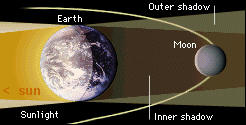What Causes an Eclipse? An eclipse occurs when the Moon, the Sun and the Earth line up directly (make a straight line with each other. There are two basic types of eclipse - lunar and solar. A lunar eclipse occurs when the Earth's shadow can be seen crossing the full Moon. In this case, the sun and the moon are on opposite sides of the Earth.
If you observe a lunar eclipse (visible only at night at the time of certain full moons), you'll see the bright lunar disk turn dark -- sometimes a coppery red color -- for as long as an hour or more.
A total eclipse of the sun (or solar eclipse) occurs when the Moon passes directly between the Sun and the Earth thus creating a huge shadow on the Earth's surface.
If you look at the diagram below you'll see that a total solar eclipse creates two shadows on the Earth. The umbra (latin for ghost) is the dark shadow where no light falls, the penumbra is the partial shadow where some light gets through. The umbra is the only place where the eclipse is ever total. Another word for this is 'Totality'.
NB this diagram is NOT to scale! In the narrow path of totality, the Moon's shadow sweeps across the land briefly turning daytime to an eerie darkness. As it starts to emerge from the shadow a bight diamond ring effect is seen.
DID YOU KNOW? .... Nearly all eclipses come in pairs (ie a lunar eclipse is followed by a solar eclipse or vice-versa). e.g. on 21-Jan-2000 there will be a Total Lunar Eclipse, it will also eclipse the sun on 05-Feb-2000. The moon has an orbital period of 27.4 days, so it orbits the Earth roughly once every month. So when there is a solar/lunar eclipse visible somewhere on Earth, another one, (the opposite eclipse type), will occur around 15 days later. Adapted from a webpage by Matthew Cook and the NASA site. (May 2001) |
Follow me...
|


 I
I







